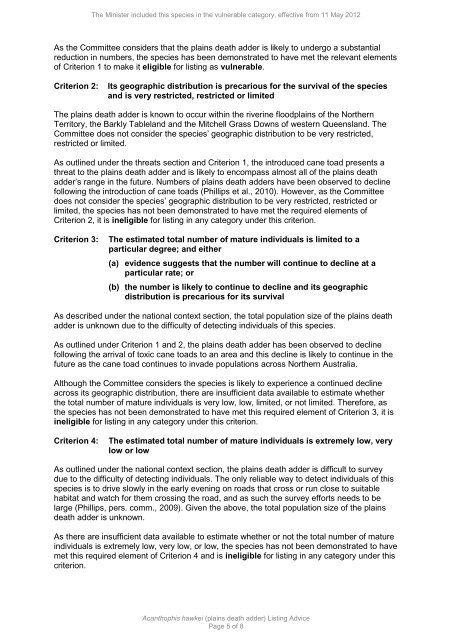Plains Death Adder - Department of the Environment, Water ...
Plains Death Adder - Department of the Environment, Water ...
Plains Death Adder - Department of the Environment, Water ...
Create successful ePaper yourself
Turn your PDF publications into a flip-book with our unique Google optimized e-Paper software.
The Minister included this species in <strong>the</strong> vulnerable category, effective from 11 May 2012<br />
As <strong>the</strong> Committee considers that <strong>the</strong> plains death adder is likely to undergo a substantial<br />
reduction in numbers, <strong>the</strong> species has been demonstrated to have met <strong>the</strong> relevant elements<br />
<strong>of</strong> Criterion 1 to make it eligible for listing as vulnerable.<br />
Criterion 2:<br />
Its geographic distribution is precarious for <strong>the</strong> survival <strong>of</strong> <strong>the</strong> species<br />
and is very restricted, restricted or limited<br />
The plains death adder is known to occur within <strong>the</strong> riverine floodplains <strong>of</strong> <strong>the</strong> Nor<strong>the</strong>rn<br />
Territory, <strong>the</strong> Barkly Tableland and <strong>the</strong> Mitchell Grass Downs <strong>of</strong> western Queensland. The<br />
Committee does not consider <strong>the</strong> species’ geographic distribution to be very restricted,<br />
restricted or limited.<br />
As outlined under <strong>the</strong> threats section and Criterion 1, <strong>the</strong> introduced cane toad presents a<br />
threat to <strong>the</strong> plains death adder and is likely to encompass almost all <strong>of</strong> <strong>the</strong> plains death<br />
adder’s range in <strong>the</strong> future. Numbers <strong>of</strong> plains death adders have been observed to decline<br />
following <strong>the</strong> introduction <strong>of</strong> cane toads (Phillips et al., 2010). However, as <strong>the</strong> Committee<br />
does not consider <strong>the</strong> species’ geographic distribution to be very restricted, restricted or<br />
limited, <strong>the</strong> species has not been demonstrated to have met <strong>the</strong> required elements <strong>of</strong><br />
Criterion 2, it is ineligible for listing in any category under this criterion.<br />
Criterion 3:<br />
The estimated total number <strong>of</strong> mature individuals is limited to a<br />
particular degree; and ei<strong>the</strong>r<br />
(a) evidence suggests that <strong>the</strong> number will continue to decline at a<br />
particular rate; or<br />
(b) <strong>the</strong> number is likely to continue to decline and its geographic<br />
distribution is precarious for its survival<br />
As described under <strong>the</strong> national context section, <strong>the</strong> total population size <strong>of</strong> <strong>the</strong> plains death<br />
adder is unknown due to <strong>the</strong> difficulty <strong>of</strong> detecting individuals <strong>of</strong> this species.<br />
As outlined under Criterion 1 and 2, <strong>the</strong> plains death adder has been observed to decline<br />
following <strong>the</strong> arrival <strong>of</strong> toxic cane toads to an area and this decline is likely to continue in <strong>the</strong><br />
future as <strong>the</strong> cane toad continues to invade populations across Nor<strong>the</strong>rn Australia.<br />
Although <strong>the</strong> Committee considers <strong>the</strong> species is likely to experience a continued decline<br />
across its geographic distribution, <strong>the</strong>re are insufficient data available to estimate whe<strong>the</strong>r<br />
<strong>the</strong> total number <strong>of</strong> mature individuals is very low, low, limited, or not limited. Therefore, as<br />
<strong>the</strong> species has not been demonstrated to have met this required element <strong>of</strong> Criterion 3, it is<br />
ineligible for listing in any category under this criterion.<br />
Criterion 4:<br />
The estimated total number <strong>of</strong> mature individuals is extremely low, very<br />
low or low<br />
As outlined under <strong>the</strong> national context section, <strong>the</strong> plains death adder is difficult to survey<br />
due to <strong>the</strong> difficulty <strong>of</strong> detecting individuals. The only reliable way to detect individuals <strong>of</strong> this<br />
species is to drive slowly in <strong>the</strong> early evening on roads that cross or run close to suitable<br />
habitat and watch for <strong>the</strong>m crossing <strong>the</strong> road, and as such <strong>the</strong> survey efforts needs to be<br />
large (Phillips, pers. comm., 2009). Given <strong>the</strong> above, <strong>the</strong> total population size <strong>of</strong> <strong>the</strong> plains<br />
death adder is unknown.<br />
As <strong>the</strong>re are insufficient data available to estimate whe<strong>the</strong>r or not <strong>the</strong> total number <strong>of</strong> mature<br />
individuals is extremely low, very low, or low, <strong>the</strong> species has not been demonstrated to have<br />
met this required element <strong>of</strong> Criterion 4 and is ineligible for listing in any category under this<br />
criterion.<br />
Acanthophis hawkei (plains death adder) Listing Advice<br />
Page 5 <strong>of</strong> 8















